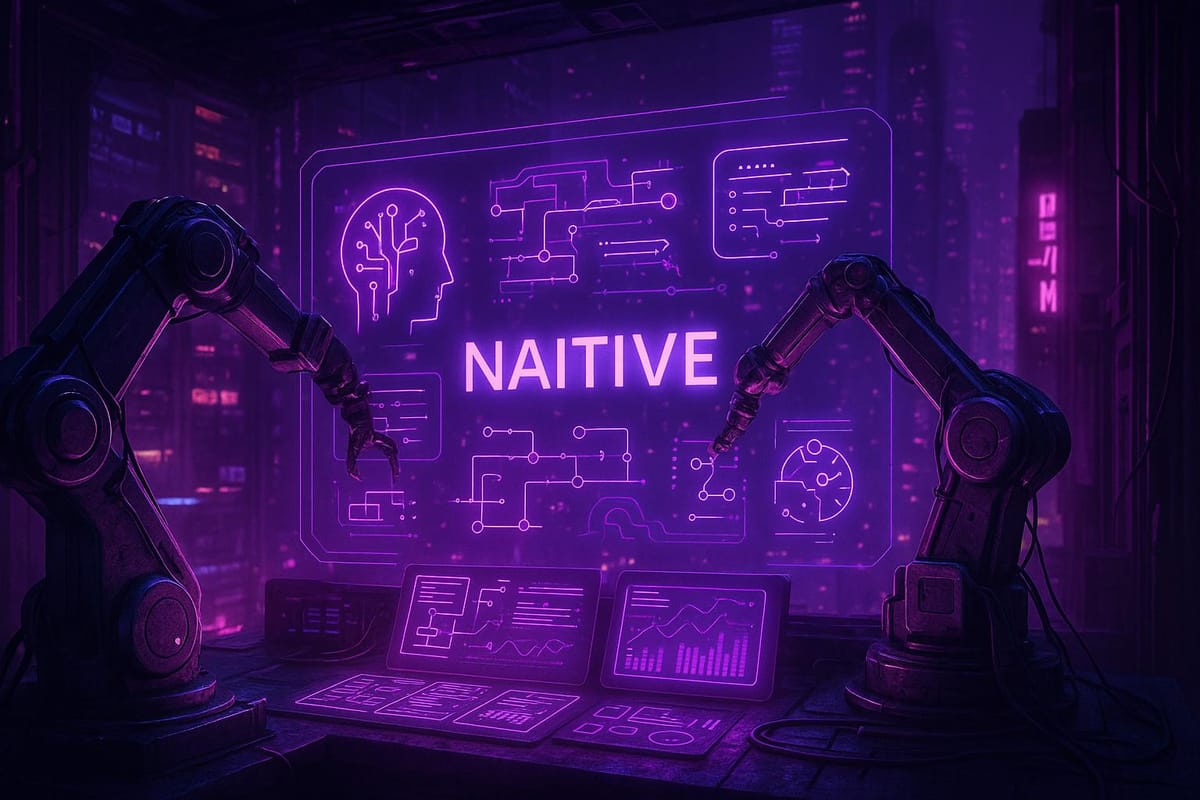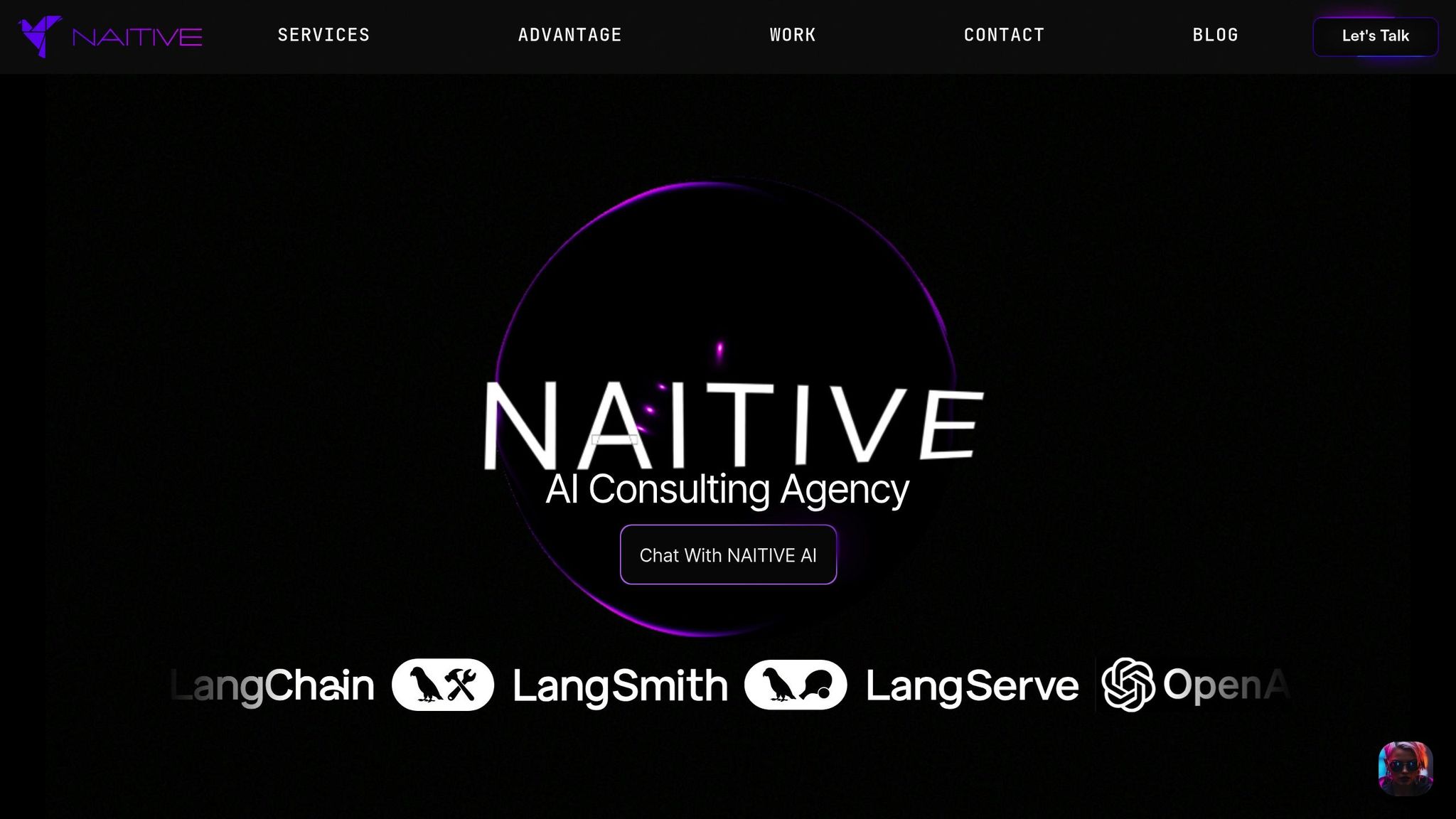Scaling AI-Driven RPA: Key Challenges
Scaling AI-driven RPA presents numerous challenges, from integration issues to talent shortages. Learn how to navigate these hurdles effectively.

Scaling AI-driven Robotic Process Automation (RPA) offers businesses the ability to automate complex processes, reduce costs, and improve efficiency. However, moving from small-scale pilots to enterprise-wide deployment comes with significant challenges:
- Integration Issues: 47% of companies face difficulties integrating RPA with legacy systems and complex IT environments.
- Security Risks: 60% of businesses cite data security concerns as a major obstacle to scaling.
- Infrastructure Limitations: Legacy systems and outdated technologies often struggle to support large-scale automation.
- Talent Shortages: A lack of skilled professionals in AI and RPA slows progress.
- Process Complexity: Overly complicated workflows hinder automation efforts.
- Cost Management: Scaling RPA can lead to hidden costs, from maintenance to system upgrades.
- Governance Gaps: Without strong frameworks, scaling can lead to inefficiencies and compliance risks.
Key Solutions:
- Invest in Cloud-Based Platforms: Flexible, scalable, and cost-effective for managing automation at scale.
- Address Talent Gaps: Train internal teams or partner with external experts like NAITIVE AI Consulting Agency.
- Simplify Workflows: Use process mining to standardize and streamline operations before automation.
- Implement Governance Frameworks: Establish Centers of Excellence to oversee security, compliance, and performance.
- Focus on End-to-End Automation: Use AI-driven RPA for processes involving unstructured data and decision-making.
Scaling RPA is achievable with the right strategy, infrastructure, and talent. By addressing these challenges early, businesses can unlock long-term efficiency and cost savings.
What Causes RPA Bot Fleet Scalability Issues? - Legal And HR SaaS Stack
Infrastructure and Integration Problems
When moving AI-driven RPA from small-scale pilot projects to full-scale enterprise deployment, many businesses encounter infrastructure challenges. Systems designed to handle a few bots often struggle when tasked with managing hundreds or even thousands of processes. These issues are especially pronounced in environments reliant on outdated technology.
Legacy System Problems
Legacy systems can be a significant obstacle to scaling automation. Many rely on outdated technologies, lack modern APIs, or use proprietary interfaces without proper documentation - none of which were built with today’s automation tools in mind. As a result, IT teams often resort to complicated workarounds that are not only costly to maintain but also prone to failure. It’s no surprise that fewer than 3% of organizations have successfully scaled RPA to more than 50 bots, with integration challenges being a major factor.
Another issue is the frequent need to update RPA scripts whenever underlying systems change. This can eat into the return on investment and slow down scaling efforts. To address these hurdles, organizations should consider deploying middleware, API gateways, or custom connectors. Tools like process mining can help identify the best integration points, while gradually phasing out or modernizing outdated components can pave the way for smoother scaling.
Cloud-Based Platform Benefits
Cloud-based RPA platforms are emerging as a game-changer for businesses aiming to scale their automation efforts. Unlike on-premises solutions, these platforms offer the flexibility to provision resources as needed, support distributed teams, and avoid hefty upfront infrastructure costs. By 2025, it’s estimated that over 20% of RPA initiatives will transition to the cloud.
These platforms come with several built-in advantages, such as disaster recovery capabilities and robust security features managed by experienced providers. They also simplify scaling by enabling centralized bot management, ensuring compliance across departments and regions, and supporting modular infrastructure that can evolve with the business.
"Our skilled team seamlessly integrates the AI solution into your existing systems and workflows, ensuring a smooth, secure and compliant deployment." - NAITIVE AI Consulting Agency
For companies looking to future-proof their automation strategies, cloud platforms provide the adaptability needed to grow and adapt over time.
System Security and Reliability Requirements
As businesses scale their RPA deployments, ensuring robust security and system reliability becomes even more critical. A larger deployment increases the attack surface, making strong security measures essential to protect sensitive data and prevent unauthorized access. Enterprises need to implement measures such as strong authentication, encryption for data in transit and at rest, user access controls, and continuous monitoring. It’s worth noting that 60% of businesses cite security risks as a significant barrier to scaling RPA, often stalling projects during the pilot phase.
Reliability is another key concern. As automation expands, systems must meet higher expectations for uptime and performance. High availability setups, failover mechanisms, and regular health checks are essential to avoid disruptions. Monitoring metrics like system uptime, bot execution success rates, error rates, and resource utilization (CPU, memory, storage) helps identify bottlenecks and optimize performance.
NAITIVE AI Consulting Agency offers managed services to address these challenges, providing ongoing updates, performance monitoring, and system optimization to ensure reliability and efficiency.
| Deployment Model | Scalability | Cost Structure | Maintenance | Security/Compliance |
|---|---|---|---|---|
| On-Premises RPA | Limited | High upfront | High | Custom, complex |
| Cloud-Based RPA | High | Subscription | Lower | Centralized, easier |
While these infrastructure and integration challenges can be daunting, they are not insurmountable. By investing in the right platforms, planning for legacy system integration, and prioritizing security from the start, organizations can set the stage for scalable automation. The next challenge? Building and managing the talent needed to sustain these advancements.
Resource Allocation and Talent Problems
After addressing infrastructure challenges, the next hurdle in scaling automation lies in assembling the right team. For many organizations, the primary barrier isn’t the technology itself - it’s finding and managing the right talent to make large-scale automation a reality.
Fixing the AI and RPA Skills Gap
A shortage of skilled professionals in AI and Robotic Process Automation (RPA) is a major roadblock for U.S. enterprises. It’s not just about hiring developers who can write code; companies need individuals who can bridge the gap between technical expertise and business operations. These professionals must understand how automation works on a technical level while also grasping the complexities of business processes.
The challenge goes deeper when it comes to strategic planning for AI. Companies often lack experts who can analyze operations, identify high-impact opportunities, and create strategies for full-scale automation deployment. Even businesses with basic RPA tools often struggle to advance into more complex areas like autonomous AI agents or multi-agent systems. Moreover, managing, debugging, testing, deploying, monitoring, and continuously improving AI solutions after implementation remains a significant challenge.
To address these gaps, companies should invest in robust training programs that combine technical and operational skills. Certification courses, hands-on workshops, and mentorship initiatives - especially those developed in partnership with universities or online learning platforms - can help build this expertise. Additionally, offering clear career paths in automation roles can improve talent retention and encourage ongoing skill development.
Cross-Department Collaboration
Scaling RPA successfully requires strong collaboration between IT and business teams. However, many companies face issues with siloed communication and unclear ownership of automation projects. IT teams focus on technical feasibility and system security, while business units prioritize efficiency and user experience. This misalignment often leads to conflicting goals and unmet expectations.
To overcome this, organizations should create cross-functional automation teams that include representatives from IT, business operations, and other key areas. Setting shared key performance indicators (KPIs) and hosting regular workshops can help align priorities and build mutual understanding. Additionally, empowering "change champions" within teams can drive adoption and make transitions smoother.
Using External Experts
When internal teams lack the necessary expertise or when scaling needs to happen quickly, bringing in external experts can be a game-changer. NAITIVE AI Consulting Agency, for example, specializes in designing, building, and managing advanced AI solutions, including autonomous agents and business process automation.
External consultants can bring in specialized skills that might take years to develop in-house, speed up deployment timelines, and provide strategic guidance drawn from cross-industry experience. For instance, NAITIVE’s "Employee as a Service" model has shown results like a 67% cost reduction and a 103% efficiency boost. These agencies can also handle ongoing tasks such as optimizing AI systems, implementing updates, fine-tuning models, and monitoring performance - allowing internal teams to focus on their core responsibilities.
For companies considering external support, it’s important to choose partners who not only implement solutions but also transfer knowledge to internal teams. A balanced approach - leveraging external expertise while building internal skills - can ensure both immediate results and long-term sustainability.
| Resource Challenge | Internal Solution | External Solution | Hybrid Approach |
|---|---|---|---|
| Skills Gap | Training programs, certifications | Consulting expertise, managed services | External implementation + internal training |
| Cross-Department Issues | Joint teams, shared KPIs | Neutral facilitation, best practices | External guidance + internal champions |
| Ongoing Management | Dedicated staff, continuous learning | Fully managed services | Managed services + knowledge transfer |
While talent and resource challenges in scaling RPA are substantial, they are far from insurmountable. By combining internal development, external expertise, or a mix of both, organizations can cultivate the human capabilities needed to support large-scale automation. Addressing these challenges early and crafting a thoughtful strategy is critical for achieving both short-term wins and sustained growth. With these hurdles managed, the next focus will be tackling process complexity.
Process Complexity and Optimization
Once you've tackled infrastructure and talent hurdles, the next big challenge in scaling AI-driven RPA is simplifying overly complex processes. Even with the best team and tools, convoluted workflows can derail automation efforts. Processes with too many decision points or dependencies across departments often lead to inconsistencies, higher maintenance costs, and limited scalability.
Take invoice processing in finance departments as an example. While it might seem like a straightforward task, handling invoices across multiple countries introduces variations in approval workflows, procedures, and compliance requirements. What looks like one workflow can quickly splinter into several distinct processes, making automation a daunting task without standardization.
Identifying and Simplifying Workflows
Tools like process mining and workflow analysis can shine a light on inefficiencies in your operations. By digging into transaction logs and exception reports, you can pinpoint bottlenecks and areas where variability is a problem. The goal? Simplify and standardize workflows before automating them. For instance, reducing the number of required approvals in an invoice workflow can turn a cumbersome process into one that's automation-ready.
Lean and Six Sigma methodologies can also help by streamlining operations and eliminating unnecessary steps. It's essential to involve process owners to ensure redesigns align with business goals and compliance standards. Collaboration across departments is equally critical - resistance to change and gaps in documentation can be addressed with clear communication, strong leadership, and ongoing training. If internal expertise is lacking, bringing in external consultants can help fast-track improvements while avoiding common pitfalls. This groundwork ensures you're selecting the right processes for automation.
Selecting the Right Processes for Automation
Not every process is a good fit for automation. A data-driven approach works best here. Look at metrics like transaction volume, error rates, cycle times, and exception frequency to identify top candidates. Processes that are high-volume, low-variability, and rule-based - like payroll management or data entry - are often the easiest to scale with RPA.
For example, in healthcare, RPA has cut claims processing time by 60% and saved 25 hours per week on manual data entry tasks. Meanwhile, the RPA market is expected to hit $5 billion by 2025, with companies reporting returns on investment as high as 3x within a year by automating straightforward tasks like accounts payable, expense reporting, and compliance workflows.
To refine your selection further, benchmark against industry standards and use predictive analytics. Processes that involve unstructured data or complex decision-making - areas where traditional RPA struggles - are ideal candidates for AI-driven RPA. This advanced approach can handle more intricate workflows while still supporting scalability.
Regulatory compliance is another critical factor. Industries like finance and healthcare face evolving rules, and automated processes must include detailed audit trails and be adaptable to new regulations.
The move toward hyperautomation - integrating RPA with AI and process mining - takes automation to the next level. This approach enables the automation of end-to-end workflows, even for complex processes. By 2025, 70% of enterprises are expected to adopt hyperautomation, making process optimization a key competitive advantage. Companies that simplify their processes today will be better equipped to leverage these advanced tools tomorrow.
Finally, success in process optimization isn’t a one-and-done effort. Establishing a framework for continuous improvement - regular reviews, performance monitoring, and stakeholder feedback - ensures your automated processes stay efficient and aligned with evolving business needs. This adaptive approach keeps your organization ready for the future.
Cost, Performance, and Governance Problems
Once processes are streamlined, organizations face a new set of hurdles: managing costs, performance, and governance when scaling robotic process automation (RPA). Expanding from a few pilot bots to full enterprise deployment often uncovers hidden costs, performance bottlenecks, and governance challenges. While 53% of businesses have already implemented RPA, many find it tough to move beyond small-scale wins to achieve sustainable, enterprise-level automation.
Controlling Total Cost of Ownership
What starts as a promising pilot can quickly turn into a financial headache as automation scales. Maintenance and support alone can account for up to 30% of total RPA costs. Add to that the need for infrastructure upgrades, rising licensing fees, and integrating with older systems - often requiring middleware or custom development - and costs can spiral. For instance, a multinational finance team automating invoice processing across various countries faced significant expenses to integrate systems and meet diverse regulatory requirements.
To tackle these challenges, NAITIVE AI Consulting Agency offers an "Employee As a Service" model to keep scaling costs under control. Key strategies include conducting detailed cost-benefit analyses, standardizing on a single automation platform, and using cloud-based solutions for better cost predictability.
Maintaining Performance and Compliance
Small glitches during pilot phases may seem manageable, but at scale, these issues can snowball. As more bots are deployed, the risk of system failures, inconsistent performance, and compliance lapses grows. Even though 92% of organizations report improved compliance after adopting RPA, maintaining that advantage at scale requires strong monitoring and governance systems.
Real-time performance monitoring and automated compliance checks are critical for keeping large-scale RPA operations on track. NAITIVE AI Consulting Agency’s managed services approach includes continuous updates, fine-tuning, and performance monitoring to ensure that scaled RPA systems perform reliably and meet compliance standards.
Building Strong Governance Frameworks
Scaling RPA without a solid governance structure can lead to chaos and inefficiency. Effective governance begins with clearly defined roles and responsibilities for managing automated processes. Many organizations establish RPA Centers of Excellence (CoEs) to oversee governance, enforce best practices, and drive continuous improvement.
Key governance measures include implementing robust security protocols, conducting regular audits, and maintaining detailed documentation of bot configurations and workflows. NAITIVE AI Consulting Agency advocates for an "agentic foundation", where AI systems are designed to adapt and align with organizational goals autonomously. Regular audits and clear escalation procedures are essential to prevent bot sprawl from undermining performance or compliance.
| Governance Challenge | Small-Scale Impact | Enterprise-Scale Impact |
|---|---|---|
| Security Risks | Limited exposure | High risk across systems |
| Compliance Monitoring | Manual oversight possible | Requires automated monitoring |
| Performance Issues | Easier to resolve | Complex troubleshooting |
| Change Management | Informal processes work | Formal procedures required |
Treating governance as an investment rather than a cost is crucial for sustainable RPA scaling. Starting with strong governance frameworks helps organizations avoid costly mistakes and compliance risks down the road. By building systems that are cost-efficient, high-performing, and well-governed, businesses can confidently scale their automation strategies across the enterprise.
Solutions and Recommendations
Scaling AI-driven RPA requires a well-rounded strategy that addresses challenges in infrastructure, talent, and processes to unlock enterprise-wide benefits. Companies that transition from isolated pilot projects to enterprise-wide automation often achieve better outcomes. The secret lies in unified planning, strategic partnerships, and scalable methods that align with business goals.
Company-Wide Automation Planning
For successful RPA scaling, crafting an enterprise-wide automation roadmap is essential. Siloed efforts often lead to inefficiencies and failed projects. A unified framework that spans departments and regions ensures consistent deployment and maximizes ROI.
To achieve this, automation goals must align with broader business objectives. Standardizing processes across departments is key, with clear and measurable outcomes - like cost savings or operational efficiency - at the forefront. For instance, finance teams often report reduced invoice processing costs, while HR departments see savings in onboarding workflows when RPA is scaled across the organization.
Starting with integrated pilot projects can set the stage for successful scaling. By focusing on processes that involve multiple departments, organizations can test how well systems work together and customize workflows before full deployment. This proactive approach helps avoid the pitfalls of fragmented automation efforts that fail to integrate with larger business processes.
RPA bots also offer a significant advantage: they work 24/7. This allows for continuous processing and real-time operations across global time zones, enhancing customer satisfaction and market responsiveness.
Investing in infrastructure is another critical step. Companies need to ensure their systems can handle increased data storage, network demands, and security requirements. While the initial costs of scaling RPA can be steep, economies of scale often lead to significant long-term savings as automation expands.
Working with NAITIVE AI Consulting Agency

Partnering with experts is a smart way to address the skills gap that often hinders RPA scaling. NAITIVE AI Consulting Agency specializes in developing and managing advanced AI solutions, including autonomous agents and process automation.
What sets NAITIVE apart is its focus on measurable outcomes rather than flashy demonstrations. Their engineers combine technical expertise with a solid understanding of business needs, ensuring that AI-driven RPA delivers practical results.
One standout offering is their "Employee As a Service" model, which helps companies manage scaling costs while accessing specialized talent. This model provides experts in areas like autonomous AI agents, voice automation, and process optimization - without the overhead of building in-house teams.
NAITIVE also excels in autonomous system design, creating AI solutions that adapt to organizational goals. This flexibility is especially valuable for scaling RPA across departments and regions, where processes often vary. Their end-to-end "Employee As a Service" approach speeds up deployment and ensures ongoing optimization, helping organizations avoid common scaling pitfalls and achieve faster results.
Scaling Strategy Comparison
Selecting the right scaling strategy depends on a company’s IT capabilities, security needs, and long-term goals. Each approach has its own advantages and challenges, requiring careful evaluation.
| Scaling Approach | Pros | Cons |
|---|---|---|
| Cloud-Based Platforms | Flexible integration, lower upfront costs, faster deployment, easy scalability | Ongoing subscription fees, potential data security risks, reliance on internet connectivity |
| On-Premises Solutions | Full data control, enhanced security, compliance flexibility | High initial investment, slower scalability, requires significant IT resources |
| In-House Deployment | Complete customization, internal knowledge retention | Demands high expertise, slower implementation, resource-intensive |
| Consulting-Led Approach | Access to specialized skills, quicker deployment, proven practices | Higher service costs, potential for dependency, less direct control |
For companies looking to scale quickly, cloud-based solutions offer flexibility and seamless integration with existing systems, avoiding the need for major overhauls. However, organizations with strict data governance requirements may lean toward on-premises solutions, despite their higher costs and complexity.
A consulting-led approach, such as working with NAITIVE AI Consulting Agency, can be particularly effective for companies lacking internal expertise or needing to scale rapidly under competitive pressure. This approach ensures access to specialized knowledge and accelerates deployment timelines.
Often, a hybrid strategy works best, blending cloud flexibility with on-premises control for sensitive processes. Starting with consulting support to establish best practices and governance frameworks, companies can gradually build internal capabilities for ongoing management and optimization.
Ultimately, the choice of scaling strategy should align with the organization’s current resources, regulatory needs, and long-term growth plans.
Conclusion: Solving AI-Driven RPA Scaling Problems
Key Points
Scaling AI-driven RPA is no small feat - it requires an organization-wide shift to tackle the interconnected challenges that come with it. From talent shortages slowing progress to governance gaps exposing security vulnerabilities, the obstacles are significant.
Take these numbers, for instance: 47% of organizations report integration issues, and 60% face security risks as they scale their bot usage. If left unresolved, these challenges can derail even the most promising automation initiatives.
A solid infrastructure is the backbone of any successful scaling effort. Without systems that can handle growing data storage needs, increased network demands, and elevated security requirements, even the best-laid RPA strategies can crumble. This infrastructure also supports the unified processes discussed in later sections.
Unified automation strategies are critical - they break down silos across the organization, creating a seamless approach to automation that sets the stage for success.
Once the infrastructure and talent challenges are under control, managing costs becomes the next hurdle. While the upfront investment in infrastructure, licensing, and training can be steep, the payoff is clear: as automation expands across departments and locations, the cost per transaction drops significantly. Finance teams, for example, have reported sharp reductions in invoice processing costs - benefits that extend to HR and supply chain operations when scaling is done thoughtfully.
But scaling isn’t a one-time effort. Staying competitive means committing to continuous improvement and ongoing investment. Automation technologies are evolving rapidly, and treating RPA as a "set it and forget it" solution won’t cut it. Instead, organizations need to focus on optimizing and growing their automation capabilities over time.
Next Steps for RPA Scaling
To scale RPA effectively, start by creating a clear, enterprise-wide automation strategy. Isolated departmental initiatives often lead to inefficiencies and missed opportunities. Assess your current processes, identify those with the highest potential impact, and integrate workflows across key areas like CRM, HR, finance, and operations to streamline complexity.
Focus on standardizing and integrating your automation tools. Fragmented solutions can create more headaches than they solve. Instead, invest in platforms that connect workflows across departments, enabling true end-to-end process management and improving scalability.
Addressing the talent gap is another urgent priority. The lack of AI and RPA expertise can slow down scaling efforts significantly. Launch cross-functional pilot projects to test integration capabilities while building internal expertise. These projects can act as a foundation for scaling initiatives across the organization.
If your organization lacks the internal expertise or needs to scale quickly to stay competitive, consider partnering with specialists like NAITIVE AI Consulting Agency. With their focus on advanced autonomous AI agents and innovative service models, they can help bridge the talent gap and ensure smooth, 24/7 operations.
Finally, regularly measure and communicate the business value of your automation efforts. This not only keeps your initiatives aligned with organizational goals but also helps maintain stakeholder support, even when challenges arise. Treating RPA scaling as a strategic transformation rather than just a tech upgrade is key to long-term success.
The potential gains are enormous, but the window for effective scaling won’t stay open forever. As RPA technology becomes more widely available, early adopters who scale strategically will gain advantages that others will struggle to match. The real question isn’t whether you should scale AI-driven RPA - it’s whether you’ll do it in a way that sets you up for sustainable success or leaves you grappling with inefficiencies and missed opportunities.
FAQs
What advantages do cloud-based platforms offer for scaling AI-driven RPA, and how do they differ from on-premises solutions?
Cloud-based platforms bring several advantages when it comes to scaling AI-driven RPA solutions. One of the biggest perks is their scalability and adaptability. Businesses can adjust resources up or down as needed, without sinking money into expensive infrastructure. This not only keeps costs in check but also boosts operational efficiency.
Another major benefit is the speed of deployment. Cloud solutions make it easier to roll out new systems and integrate them with existing tools, which is a game-changer for companies focused on streamlining their operations. Plus, businesses gain access to the latest AI updates and features, helping them stay competitive in an ever-changing market.
On the other hand, on-premises solutions often come with higher upfront costs for hardware and ongoing maintenance, which can make scaling more challenging. While these setups might give businesses tighter control over data and security, cloud platforms typically offer strong security protocols and compliance options. For most companies, this makes cloud platforms a practical and efficient choice for growth.
What can businesses do to overcome the shortage of skilled professionals in AI and RPA when scaling their automation projects?
Businesses struggling to find skilled professionals in AI and RPA can address this issue by turning to AI consulting services. Experienced consultants, such as those at NAITIVE AI Consulting Agency, can step in to design, implement, and manage customized AI-powered automation solutions that align with your specific business goals.
Another effective approach is investing in upskilling your current workforce. By offering targeted training programs in AI and RPA technologies, companies can empower their teams to handle automation projects more effectively. Combining external expertise with internal skill development not only helps scale automation efforts but also sets the stage for sustained innovation.
How can businesses address integration challenges with legacy systems when scaling AI-driven RPA?
Integrating AI-powered RPA with older systems can often feel like navigating a maze, thanks to outdated technologies and limited compatibility. But there are ways to make the process smoother. Businesses can turn to strategies like middleware solutions to fill compatibility gaps, APIs to enable seamless communication, and selectively upgrading key components of legacy systems when possible.
Another smart move? Collaborating with specialists in AI and automation. Take consulting firms like NAITIVE AI, for instance. They focus on crafting custom solutions that help businesses integrate AI technologies into their existing setups with minimal hiccups, paving the way for smoother operations and long-term scalability.




